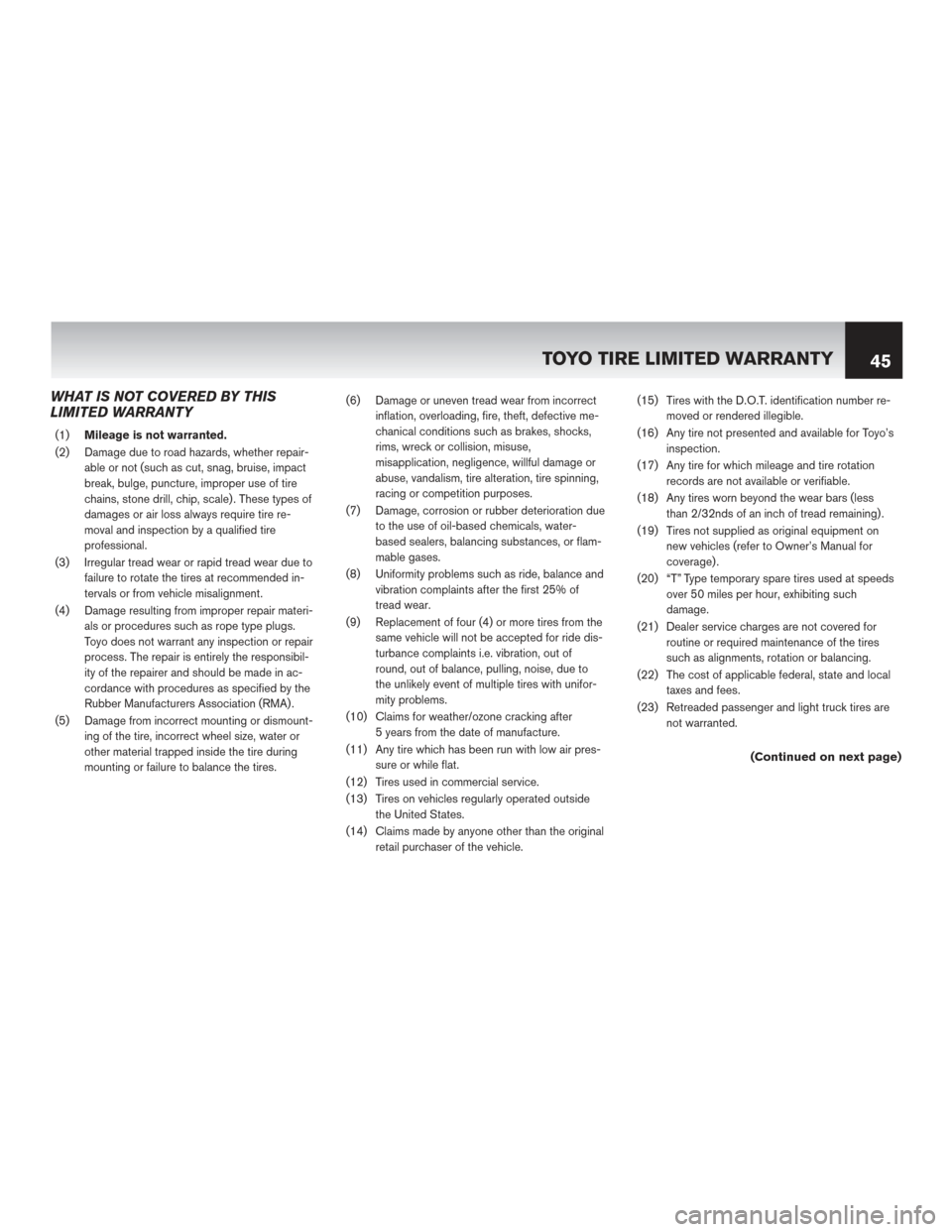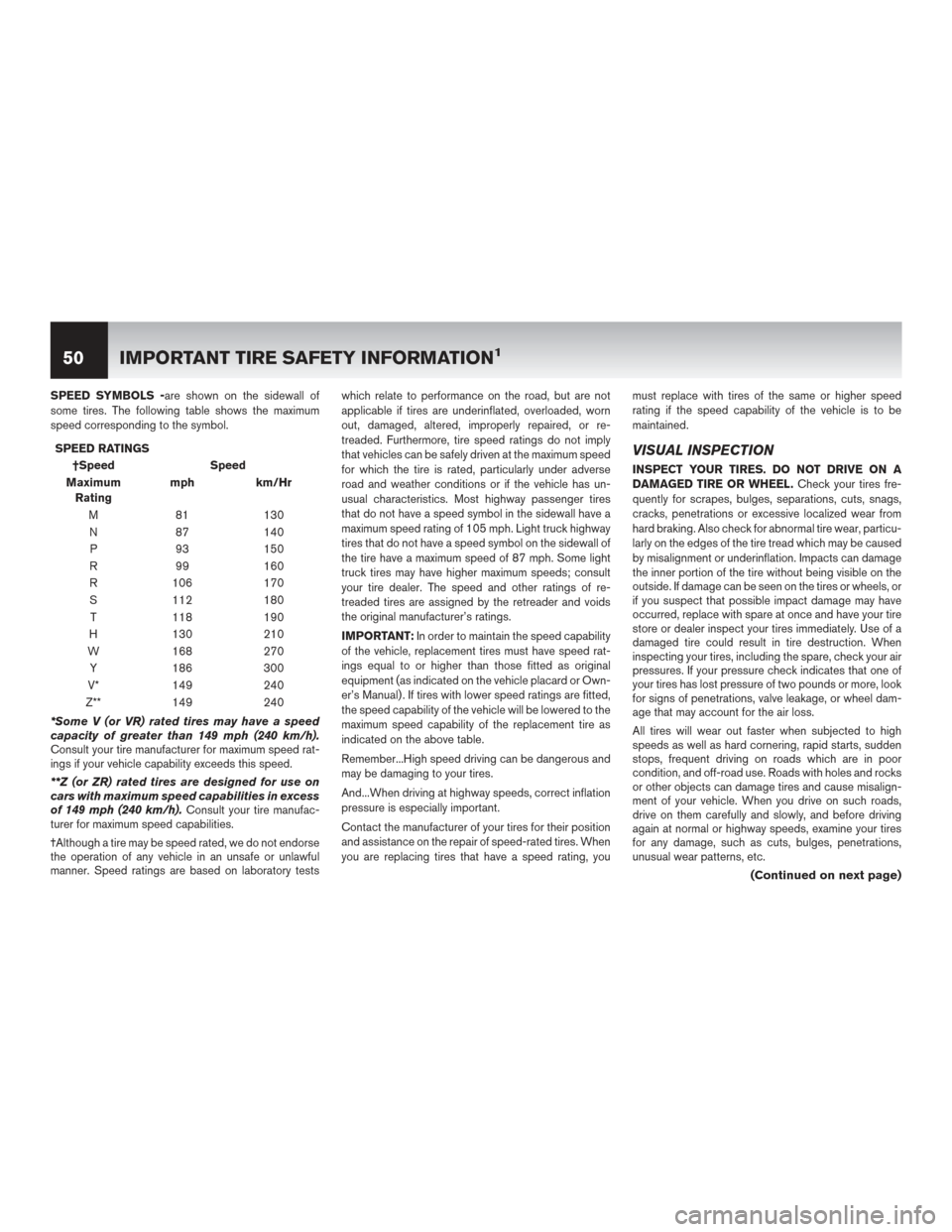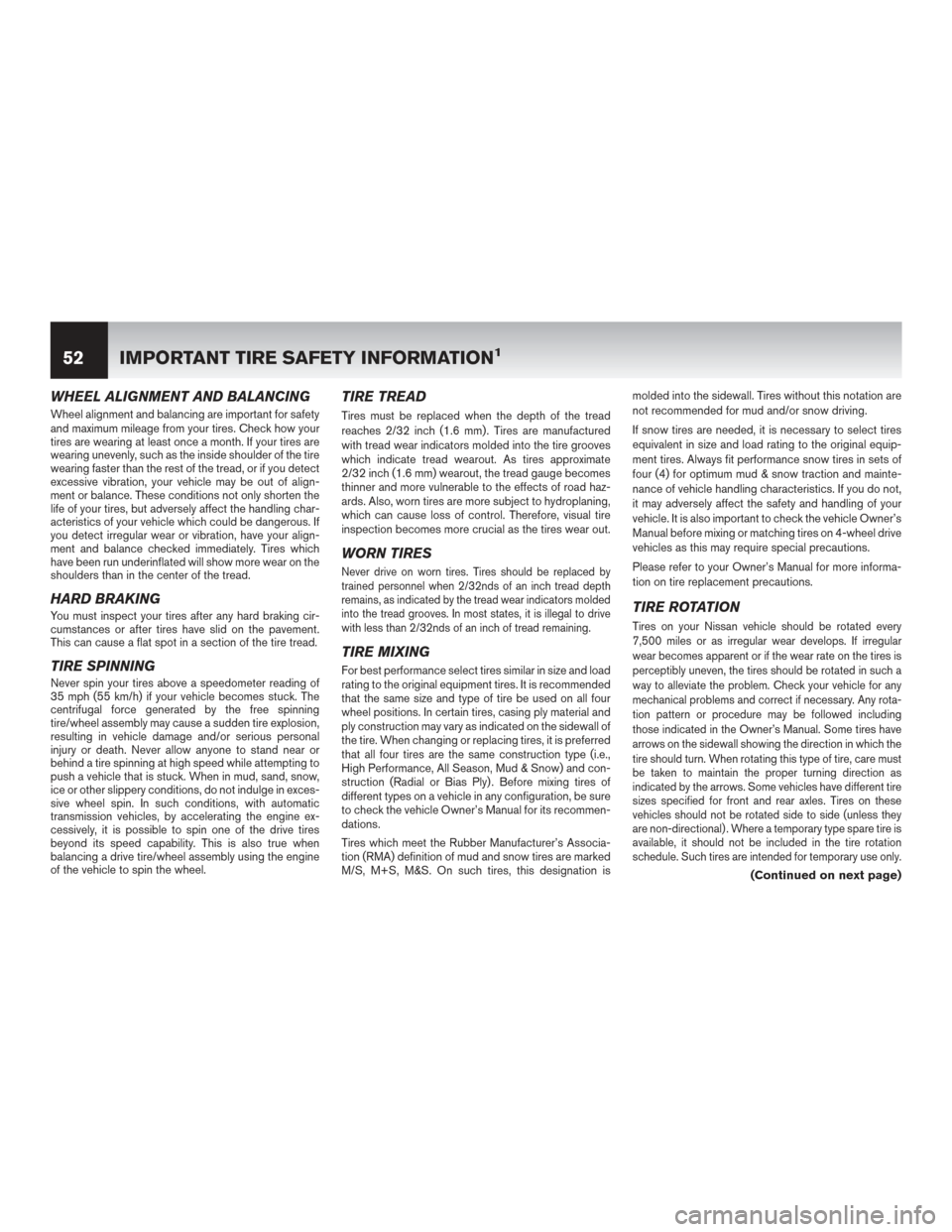2014 NISSAN CUBE wheel alignment
[x] Cancel search: wheel alignmentPage 49 of 70

WHAT IS NOT COVERED BY THIS
LIMITED WARRANTY
(1)Mileage is not warranted.
(2) Damage due to road hazards, whether repair- able or not (such as cut, snag, bruise, impact
break, bulge, puncture, improper use of tire
chains, stone drill, chip, scale) . These types of
damages or air loss always require tire re-
moval and inspection by a qualified tire
professional.
(3) Irregular tread wear or rapid tread wear due to failure to rotate the tires at recommended in-
tervals or from vehicle misalignment.
(4) Damage resulting from improper repair materi- als or procedures such as rope type plugs.
Toyo does not warrant any inspection or repair
process. The repair is entirely the responsibil-
ity of the repairer and should be made in ac-
cordance with procedures as specified by the
Rubber Manufacturers Association (RMA) .
(5) Damage from incorrect mounting or dismount- ing of the tire, incorrect wheel size, water or
other material trapped inside the tire during
mounting or failure to balance the tires. (6) Damage or uneven tread wear from incorrect
inflation, overloading, fire, theft, defective me-
chanical conditions such as brakes, shocks,
rims, wreck or collision, misuse,
misapplication, negligence, willful damage or
abuse, vandalism, tire alteration, tire spinning,
racing or competition purposes.
(7) Damage, corrosion or rubber deterioration due to the use of oil-based chemicals, water-
based sealers, balancing substances, or flam-
mable gases.
(8) Uniformity problems such as ride, balance and vibration complaints after the first 25% of
tread wear.
(9) Replacement of four (4) or more tires from the same vehicle will not be accepted for ride dis-
turbance complaints i.e. vibration, out of
round, out of balance, pulling, noise, due to
the unlikely event of multiple tires with unifor-
mity problems.
(10) Claims for weather/ozone cracking after 5 years from the date of manufacture.
(11) Any tire which has been run with low air pres- sure or while flat.
(12) Tires used in commercial service.
(13) Tires on vehicles regularly operated outside the United States.
(14) Claims made by anyone other than the original retail purchaser of the vehicle. (15) Tires with the D.O.T. identification number re-
moved or rendered illegible.
(16) Any tire not presented and available for Toyo’s inspection.
(17) Any tire for which mileage and tire rotation records are not available or verifiable.
(18) Any tires worn beyond the wear bars (less than 2/32nds of an inch of tread remaining) .
(19) Tires not supplied as original equipment on new vehicles (refer to Owner’s Manual for
coverage) .
(20) “T” Type temporary spare tires used at speeds over 50 miles per hour, exhibiting such
damage.
(21) Dealer service charges are not covered for routine or required maintenance of the tires
such as alignments, rotation or balancing.
(22) The cost of applicable federal, state and local taxes and fees.
(23) Retreaded passenger and light truck tires are not warranted.
(Continued on next page)
TOYO TIRE LIMITED WARRANTY 45
Page 54 of 70

SPEED SYMBOLS -are shown on the sidewall of
some tires. The following table shows the maximum
speed corresponding to the symbol.SPEED RATINGS †Speed Speed
Maximum Rating mph km/Hr
M 81 130
N 87 140
P 93 150
R 99 160
R 106 170
S 112 180
T 118 190
H 130 210
W 168 270
Y 186 300
V* 149 240
Z** 149 240
*Some V (or VR) rated tires may have a speed
capacity of greater than 149 mph (240 km/h).
Consult your tire manufacturer for maximum speed rat-
ings if your vehicle capability exceeds this speed.
**Z (or ZR) rated tires are designed for use on
cars with maximum speed capabilities in excess
of 149 mph (240 km/h). Consult your tire manufac-
turer for maximum speed capabilities.
†Although a tire may be speed rated, we do not endorse
the operation of any vehicle in an unsafe or unlawful
manner. Speed ratings are based on laboratory tests which relate to performance on the road, but are not
applicable if tires are underinflated, overloaded, worn
out, damaged, altered, improperly repaired, or re-
treaded. Furthermore, tire speed ratings do not imply
that vehicles can be safely driven at the maximum speed
for which the tire is rated, particularly under adverse
road and weather conditions or if the vehicle has un-
usual characteristics. Most highway passenger tires
that do not have a speed symbol in the sidewall have a
maximum speed rating of 105 mph. Light truck highway
tires that do not have a speed symbol on the sidewall of
the tire have a maximum speed of 87 mph. Some light
truck tires may have higher maximum speeds; consult
your tire dealer. The speed and other ratings of re-
treaded tires are assigned by the retreader and voids
the original manufacturer’s ratings.
IMPORTANT:
In order to maintain the speed capability
of the vehicle, replacement tires must have speed rat-
ings equal to or higher than those fitted as original
equipment (as indicated on the vehicle placard or Own-
er’s Manual) . If tires with lower speed ratings are fitted,
the speed capability of the vehicle will be lowered to the
maximum speed capability of the replacement tire as
indicated on the above table.
Remember...High speed driving can be dangerous and
may be damaging to your tires.
And...When driving at highway speeds, correct inflation
pressure is especially important.
Contact the manufacturer of your tires for their position
and assistance on the repair of speed-rated tires. When
you are replacing tires that have a speed rating, you must replace with tires of the same or higher speed
rating if the speed capability of the vehicle is to be
maintained.
VISUAL INSPECTION
INSPECT YOUR TIRES. DO NOT DRIVE ON A
DAMAGED TIRE OR WHEEL.
Check your tires fre-
quently for scrapes, bulges, separations, cuts, snags,
cracks, penetrations or excessive localized wear from
hard braking. Also check for abnormal tire wear, particu-
larly on the edges of the tire tread which may be caused
by misalignment or underinflation. Impacts can damage
the inner portion of the tire without being visible on the
outside. If damage can be seen on the tires or wheels, or
if you suspect that possible impact damage may have
occurred, replace with spare at once and have your tire
store or dealer inspect your tires immediately. Use of a
damaged tire could result in tire destruction. When
inspecting your tires, including the spare, check your air
pressures. If your pressure check indicates that one of
your tires has lost pressure of two pounds or more, look
for signs of penetrations, valve leakage, or wheel dam-
age that may account for the air loss.
All tires will wear out faster when subjected to high
speeds as well as hard cornering, rapid starts, sudden
stops, frequent driving on roads which are in poor
condition, and off-road use. Roads with holes and rocks
or other objects can damage tires and cause misalign-
ment of your vehicle. When you drive on such roads,
drive on them carefully and slowly, and before driving
again at normal or highway speeds, examine your tires
for any damage, such as cuts, bulges, penetrations,
unusual wear patterns, etc.
(Continued on next page)
50 IMPORTANT TIRE SAFETY INFORMATION1
Page 56 of 70

WHEEL ALIGNMENT AND BALANCING
Wheel alignment and balancing are important for safety
and maximum mileage from your tires. Check how your
tires are wearing at least once a month. If your tires are
wearing unevenly, such as the inside shoulder of the tire
wearing faster than the rest of the tread, or if you detect
excessive vibration, your vehicle may be out of align-
ment or balance. These conditions not only shorten the
life of your tires, but adversely affect the handling char-
acteristics of your vehicle which could be dangerous. If
you detect irregular wear or vibration, have your align-
ment and balance checked immediately. Tires which
have been run underinflated will show more wear on the
shoulders than in the center of the tread.
HARD BRAKING
You must inspect your tires after any hard braking cir-
cumstances or after tires have slid on the pavement.
This can cause a flat spot in a section of the tire tread.
TIRE SPINNING
Never spin your tires above a speedometer reading of
35 mph (55 km/h) if your vehicle becomes stuck. The
centrifugal force generated by the free spinning
tire/wheel assembly may cause a sudden tire explosion,
resulting in vehicle damage and/or serious personal
injury or death. Never allow anyone to stand near or
behind a tire spinning at high speed while attempting to
push a vehicle that is stuck. When in mud, sand, snow,
ice or other slippery conditions, do not indulge in exces-
sive wheel spin. In such conditions, with automatic
transmission vehicles, by accelerating the engine ex-
cessively, it is possible to spin one of the drive tires
beyond its speed capability. This is also true when
balancing a drive tire/wheel assembly using the engine
of the vehicle to spin the wheel.
TIRE TREAD
Tires must be replaced when the depth of the tread
reaches 2/32 inch (1.6 mm) . Tires are manufactured
with tread wear indicators molded into the tire grooves
which indicate tread wearout. As tires approximate
2/32 inch (1.6 mm) wearout, the tread gauge becomes
thinner and more vulnerable to the effects of road haz-
ards. Also, worn tires are more subject to hydroplaning,
which can cause loss of control. Therefore, visual tire
inspection becomes more crucial as the tires wear out.
WORN TIRES
Never drive on worn tires. Tires should be replaced by
trained personnel when 2/32nds of an inch tread depth
remains, as indicated by the tread wear indicators molded
into the tread grooves. In most states, it is illegal to drive
with less than 2/32nds of an inch of tread remaining.
TIRE MIXING
For best performance select tires similar in size and load
rating to the original equipment tires. It is recommended
that the same size and type of tire be used on all four
wheel positions. In certain tires, casing ply material and
ply construction may vary as indicated on the sidewall of
the tire. When changing or replacing tires, it is preferred
that all four tires are the same construction type (i.e.,
High Performance, All Season, Mud & Snow) and con-
struction (Radial or Bias Ply) . Before mixing tires of
different types on a vehicle in any configuration, be sure
to check the vehicle Owner’s Manual for its recommen-
dations.
Tires which meet the Rubber Manufacturer’s Associa-
tion (RMA) definition of mud and snow tires are marked
M/S, M+S, M&S. On such tires, this designation ismolded into the sidewall. Tires without this notation are
not recommended for mud and/or snow driving.
If snow tires are needed, it is necessary to select tires
equivalent in size and load rating to the original equip-
ment tires. Always fit performance snow tires in sets of
four (4) for optimum mud & snow traction and mainte-
nance of vehicle handling characteristics. If you do not,
it may adversely affect the safety and handling of your
vehicle. It is also important to check the vehicle Owner’s
Manual before mixing or matching tires on 4-wheel drive
vehicles as this may require special precautions.
Please refer to your Owner’s Manual for more informa-
tion on tire replacement precautions.
TIRE ROTATION
Tires on your Nissan vehicle should be rotated every
7,500 miles or as irregular wear develops. If irregular
wear becomes apparent or if the wear rate on the tires is
perceptibly uneven, the tires should be rotated in such a
way to alleviate the problem. Check your vehicle for any
mechanical problems and correct if necessary. Any rota-
tion pattern or procedure may be followed including
those indicated in the Owner’s Manual. Some tires have
arrows on the sidewall showing the direction in which the
tire should turn. When rotating this type of tire, care must
be taken to maintain the proper turning direction as
indicated by the arrows. Some vehicles have different tire
sizes specified for front and rear axles. Tires on these
vehicles should not be rotated side to side (unless they
are non-directional) . Where a temporary type spare tire is
available, it should not be included in the tire rotation
schedule. Such tires are intended for temporary use only.
(Continued on next page)
52
IMPORTANT TIRE SAFETY INFORMATION1